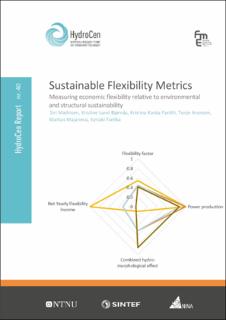| dc.description.abstract | This report is written as part of the multidisciplinary Work Package 5 in HydroCen. Increased production from variable renewable energy sources leads to a higher demand for flexible power sources to fill the gap with low-variable production. At the same time, a review of the environmental requirements for Nordic hydropower systems, due to new regulations for sustainable activities and long-planned hydro-power concession revisions, may lead to several new constraints for hydropower production with the aim of ensuring sustainable use of water and improved balance between multiple uses of water. Conse-quently, we see an increased need for methods and tools that can quantify the effect of environmental requirements on energy and flexibility and distinguish between the two. This can help us improve the balance between energy production and the environmental consequences, and also better inform us about the costs of flexibility for nature, and vice versa.
This report describes the first steps towards establishing a framework for systematic quantification of the regulation capabilities of hydropower in terms of a set of metrics and the trade-offs between them. The framework considers trade-offs between different operational patterns, balancing profitable opera-tion and environmental impacts. Together, the system of trade-offs between indicators or metrics for different aspects of flexible operation will be a tool for assessing how regulation and flexibility can be obtained from hydropower systems with minimal impact on other factors, such as the environment and costs. The assessment system will also give information about the sensitivity of different regulatory con-straints to the ability to provide flexibility from hydropower systems. The assessment system and the individual metrics can be a valuable knowledge base for revision of terms and refurbishment of hydro-power systems in future, because it will provide information on the drivers behind capabilities, econom-ical profit and environmental impacts of flexible operation of hydropower.
For two separate watercourses, Aura and Surna, there are four case studies with a variety of environ-mental constraints: Constant and time-varying constraints on water bypassing a hydropower plant, on the run-down of the flow in part of a river and on the minimum flow in part of a river. These case studies are assessed using combinations of five independent metrics: the flexibility factor, the produced power, the net yearly flexibility loss, the salmon smolt production and the combined hydromorphological effect (EnviPEAK). The cases include proposed and implemented concession revisions as well as cases aimed at preserving the environment in the water course.
The report concludes that the flexibility quantification framework proposed is indeed a foundation for systematic quantification of the regulation capabilities of hydropower in terms of a set of metrics and the trade-offs between them. The report recommends further testing of the developed framework using different combinations of environmental constraints on the hydropower production planning, different environmental considerations, environmental metrics in the reservoirs, and that the industry should be given an increased opportunity to test and evaluate the value of the metrics in production planning, and the useability of, the framework. The assessment framework contributes to a quantification of the cost in terms of the flexibility to preserve the environment around a watercourse, but the report also recom-mends that more research should be done to search for complimentary good and easily understandable flexibility metrics. We recommend further research to quantify the cost in terms of environmental impact on the flexibility of hydropower planning, especially with future value and use of nature in mind. We also recommend more research projects that increase the experience in multidisciplinary work, as this is im-portant to understand a broader picture and the impacts of choices made in one discipline on other research fields. | en_US |
